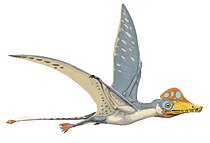Yixianopterus
| Yixianopterus Temporal range: Early Cretaceous,
| |
|---|---|
| Scientific classification | |
| Domain: | Eukaryota |
| Kingdom: | Animalia |
| Phylum: | Chordata |
| Order: | †Pterosauria |
| Suborder: | †Pterodactyloidea |
| Clade: | †Istiodactyliformes |
| Genus: | †Yixianopterus Lü et al., 2006 |
| Type species | |
| †Yixianopterus jingangshanensis Lü et al., 2006
| |
Yixianopterus is a pterodactyloid pterosaur genus from the Barremian-Aptian-age Lower Cretaceous Yixian Formation of Liaoning, China. It is known from a single specimen, holotype JZMP-V-12, housed at the Benxi Geological Museum. This specimen was modified before acquisition, with much of the skull being fabricated.[1] The Jinggangshan bedding in which the specimen was found is basaltic with siliciclastic sediments.[2] Many organisms associated with this layer of the Yixian Formation are aquatic, indicating a marine environment with much volcanic activity.
Classification
[edit]Lü et al. (2006) assigned Yixianopterus to the Lophocratian family Lonchodectidae based on dental characters, and ratio comparisons between wing phalanx I and II, metacarpal IV, and ulna. This specimen was classified it as the first Asian representative of Lonchodectidae.[3] Martill (2011) considered it potentially related to his new taxon Unwindia,[4] and Witton (2013) assigned it to the family Ornithocheiridae.[5]
A reappraisal of the holotype specimen and phylogenetic analysis by Jiang et al. (2020) recovered Yixianopterus as a basal member of the clade Istiodactyliformes:
Holotype JZMP-V-12
[edit]Holotype JZMP-V-12 was discovered within the Jinggangshan bedding, the uppermost layer of the Yixian Formation.[2] Many Jehol Biota associated with the Jinggangshan bedding are fish, ephemerid, and plant fragments. The holotype found contained fragmented segments leading to its classification as a new genus and species of flying reptile from the Early Cretaceous. Preserved segments include the right forelimb, a foot, and teeth.[1]
The recovered right forelimb segment contained two broad, thin plates each measuring 35 cm x 35 cm x 2 cm. The conditions under which the holotype was preserved crushed the ends of the right humerus, but what remains is 101.6 mm long.[1] The deltopectoral crest of the upper humerus, extending a quarter of the length (25.38mm), characterized the specimen as belonging to Pteranodontoidea.
The foot of holotype JZMP-V-12 was found in a well-preserved condition. Metatarsal III is 28.19mm long while what was preserved of the tibia is 102.63 mm in length. Kellner et al. (2019) identified the ratio as less than 27.5%, a typical characteristic of the clade Ornithocheiroidea.[1]
Lü et al. (2006) identified the ratios between wing phalanx I and II, wing phalanx I and metacarpal IV, and metacarpal IV and ulna, as being unique to Yixianopterus[3].
Lü et al. (2006) noted that the teeth of the specimen were subequal with diastema increasing posteriorly.[3] Kellner et al. (2019) identified the triangular and labiolingually compressed teeth as a characteristic of Pteranodontoidea. The front two incisors are particularly more slender and longer than the rest.[1]
An outline of the head preserved within the sediment showed a dorsal inclination.[1] This would indicate that the shape of the skull is rather narrow where the mouth opening is, with the majority of the skull surrounding the brain.
References
[edit]- ^ a b c d e f Shun-Xing, Jiang; Xin-Jun, Zhang; Xin, Cheng; Xiao-Lin, Wang. "A new pteranodontoid pterosaur forelimb from upper Yixian Formation, with a revision of Yixianopterus jingangshanesis". Vertebrata PalAsistica. 59 (2): 81–94.
- ^ a b Qin, Zuohuan; Xi, Dangpeng; Shi, Zhongye; Xu, Yankang; Wei, Feng; Yu, Zhiqiang; Wu, Baoxu; Wan, Xiaoqiao (January 4, 2019). "Lagerstätte fossils from the Lower Cretaceous Yixian Formation of the Pingquan Basin, North China: stratigraphical correlation and palaeoenvironmental implications". Lethaia. 52 (3): 335–349. doi:10.1111/let.12315.
- ^ a b c Lü, J; Ji, S; Yuan, C; Gao, Y; Sun, Z; Ji, Q (2006). "New pterodactyloid pterosaur from the Lower Cretaceous Yixian Formation of Western Liaoning". Papers from the 2005 Heyuan International Dinosaur Symposium. Beijing: Geological Publishing House: 195–203.
- ^ Martill, David M (2011). "A new pterodactyloid pterosaur from the Santana Formation (Cretaceous) of Brazil". Cretaceous Research. 32 (2): 236–243. doi:10.1016/j.cretres.2010.12.008.
- ^ Witton, Mark P (2013). Pterosaurs: Natural History, Evolution, Anatomy. Princeton, NJ: Princeton University Press.












